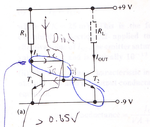lucky6969b
Member level 2
https://en.wikipedia.org/wiki/Current_mirror
I don't understand if the positive rail is +9V and negative rail is -9V
Why the current is 18V - 0.65V / Rc?
Anyone explain this?
Thanks
Jack
I don't understand if the positive rail is +9V and negative rail is -9V
Why the current is 18V - 0.65V / Rc?
Anyone explain this?
Thanks
Jack
